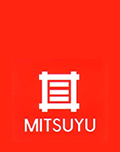- To English page ⇒ ⇒ click
三露産業百年史
- 1887年(明治20年)
- ■創業
初代・三露久兵衛が37歳のとき、出身の滋賀県蒲生郡老蘇村内野(現・安土町内野)から大阪に移り、大阪市東区北久太郎町3丁目に店舗を構えて織物商をはじめました。
- 当時の三露商店は若くして卓越した人物であった山本恒助により切り廻されていました。山本恒助は晒小巾を中心とする内地問屋としての業務を全面的に担当し、輸出貿易の開拓に全力を注ぎました。
- 明治末期
- ■海外進出が加速
朝鮮・台湾向けの売りこみで大きな成果をあげた貿易事業では、当社商標「案山子」の晒細布が爆発的な売れ行きを示しました。
- 東南アジア方面に対しては各種加工綿布の販売に注力。紡績や商社の大手が手をつけない加工品・特殊品(その多くは「柘榴(ざくろ)」商標で輸出)を主に扱い、金柘榴・銀柘榴の名前は南洋方面で有名ブランドの1つに数えられるようになりました。
- 1921年(大正10年)
- ■株式会社三露商店の発足
創業者の三露久兵衛が享年72歳で逝去。婿養子の幾太郎が久兵衛を襲名しました。5月5日には株式会社三露商店を設立法人組織に改組し、英文名Mitsuyu
Co.,Ltdの商号で本格的な直輸出に取り組みました。
- この頃は、ビルマ向け、エジプト向け、セイロン(現スリランカ)向け、インドネシア向けに晒細布の商標を取得し、色金巾等河口綿布輸出商としての基盤を確立。取扱高も急速に増加し、取引先関係会社の応援でフィリピンに駐在員を送ったり、ジャワ(現インドネシア)向けサロン布輸出にも進出するなど、事業を拡大しました。
- 1941年(昭和16年)
- ■太平洋戦争勃発
日中戦争以降、産業も軍需産業が優先となっていた日本では、太平洋戦争に至ってからは繊維が統制されて配給制になり、当社も役員・社員が軍役に召集されたことで、活動の縮小を余儀なくされました。
- 1945年(昭和20年)
- ■本社社屋が空襲で全焼
3月13日、アメリカ軍の大阪大空襲が発生。これにより、本社社屋は全焼し、活動は休眠状態になりました。
- 1948年(昭和23年)
- ■社名を「三露産業株式会社」に変更
6月15日、高麗橋の東洋綿花別館に事務所を開設。9月には焼地跡の東区久太郎町2丁目に本社社屋を新築し、事業を再開しました。
- 事業再開後は旧知の海外バイヤーが続々と来日。戦前に輸出していたインドネシアやタイなどへ当社商標の晒細布、晒金布、サロン布の輸出も再開。国内販売においても戦前からの小巾木綿に加えて広巾織物の取扱いも拡大しました。
- 1951年(昭和26年)
- ■東京出張所を開設
嘱託で非繊維商材の取扱いも開始。この年末には人員も130名に拡大し、最も充実した時期になりました。
- 1952年(昭和27年)
- ■経営危機を経て成長の途へ
朝鮮戦争の休戦で繊維を中心とする商品相場が暴落し、海外市場で大量の契約キャンセルが発生。それに伴う値下がり損、貸倒れ債権の多発などで、自立では営業継続が不能に。
- 同年9月に大下真吉を社長に迎え、建て直しを図りました。その後、積極的な対米輸出に乗り出し、業績を伸ばしていきます。
- 1959年(昭和34年)
- ■三露久一郎が社長に就任
大下社長は会長に、三露久一郎が社長に就任しました。
- 久一郎は日本繊維製品輸出組合の監事および布帛部会の委員長を務め、日米繊維交渉にあたっては業界代表として渡米交渉にも参加しました。
- 1966年(昭和41年)
- ■本社社屋を建設
現在の大阪市中央区南本町1丁目18番地の1に、地上3階・鉄筋コンクリート造の本社社屋を建設。同年10月に営業を開始しました。
- 1977年(昭和52年)
- ■経営改革で苦境を打開
國澤亀寿朗が社長に就任。不動産処分や在庫の圧縮を遂行し、この後は中国綿布の取扱いの開始や、泉州地区織布業者、大手紡績会社との取引が増加して売上高が順調に回復。150〜170億円の年商を上げるに至りました。



